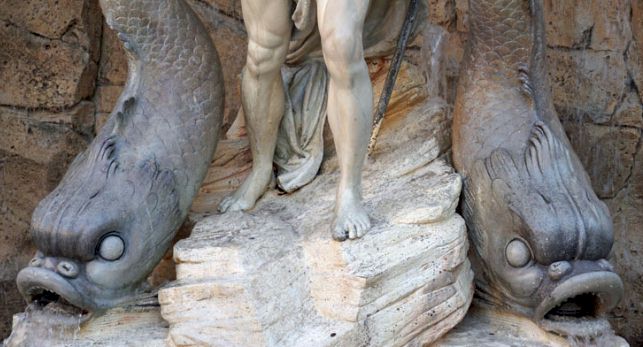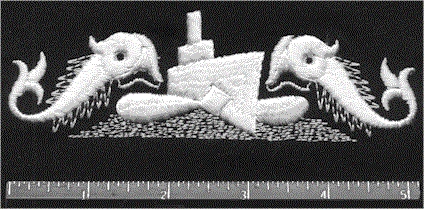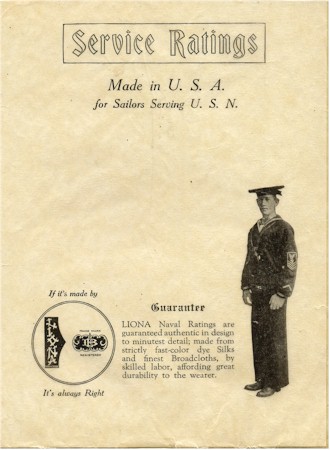"DOLPHINS" - the Submarine Warefare Insignia "Life
is simple - either you're qualified or you're not!"
History of the Submariner's Dolphins Dolphins - fish or mammal? I've received querys as to whether a fish or a mammal is used
on the U.S. Submarine Warfare insignia. It is a bottlenose dolphin, but a stylized version
of this mammal. Dolphins don't have scales, but as can be found in classical
depictions, scales were added
for artistic effect. (see image below)
Dolphin Collection (enlisted)
In 1967, the manufacturer, Vanguard discontinued
their "sterling" dolphins, in favor of less expensive silver plate or silver
oxide surfaces. It is probable that the other manufacturers did the same
- and at about the same time to remain competitive. ...and the
"mystery" dolphins?
This large (5") silk embroidered, patch came in the cellophane envelope [below] and appears to
be from the 1920's or '30s.
It is exactly twice the size of the early sleeve insignias, and too large
to be used as a decorative "liberty" cuff.
If anyone knows how it was worn - let me know....
"I remember once or twice seeing these large
patches sewn underneath neck flap on dress blue jumpers, much as liberty
cuffs were sewn inside sleeve cuffs...I myself have a lot of embroidered
items underneath my collar including sleeve devices with diesel boat
names that I served on." I also received word from a TM off the Wahoo who recalled that he had this
same patch sewn inside the flap on his dress blue trousers. So it appears that
it wasn't produced for any authorized use on the uniform.
Article by
If you have any questions or comments, email me: gary@brewerygems.com
All contents including images are copyright by AboutSubs.com

![]()
The insignia of the U.S. submarine service is a submarine flanked by two dolphins. Dolphins,
attendants to the Poseidon, Greek god of the sea and patron deity to sailors, is
sometimes referred to as the sailor's friend. They were also chosen to
represent the Submarine Service because of the characteristic way in which
dolphins dive and surface.
On 13 June 1923, Captain E. J. King, Commander, Submarine
Division Three (later Fleet Admiral and Commander in Chief, U.S. Fleet, during
WW II), suggested to the Secretary of the Navy via the Bureau of Navigation (now
known as BuPers) that a distinguishing device for qualified submariners be
adopted. He submitted a pen-and-ink sketch of his own showing a shield mounted
on the beam ends of a submarine, with dolphins forward of, and abaft, the
conning tower.
The suggestion was strongly endorsed by Commander Submarine
Division Atlantic. Over the next several months the Bureau of Navigation
solicited additional designs from several sources. Some combined a submarine
with a shark motif. Others showed submarines and dolphins, and still others used
a shield design.
A Philadelphia firm, Bailey, Banks & Biddle (BB&B), which had
done work in the field of Naval crests, was approached by the Bureau of
Navigation with the request that it design a suitable badge. Two designs were
submitted by the firm, one of which was to be used for the U.S. Naval
Academy's 1926 class crest, which had been designed by under-classman William C.
Eddy in 1922. These two designs were combined into a single concept. It was a
starboard angle on the bow view of an "O" class submarine, proceeding on the
surface, with bow planes rigged for diving, flanked by dolphins in a horizontal
position with their heads resting on the upper edge of the bow planes.
On 20
March 1924, the Chief of the Bureau of Navigation recommended to the Secretary
of the Navy that the design be adopted. The recommendation was accepted by
Theodore Roosevelt, Jr., Acting Secretary of the Navy. His acceptance is dated
March 1924. Today the original BB&B design is used by many manufactures without
modification, while others choose to take some artistic license, especially in
updating the class of submarine depicted.
The submarine insignia was to be worn at all times by officers
and men qualified in submarine duty attached to submarine units or
organizations, ashore and afloat, and not to be worn when not attached. In 1941
the Uniform Regulations were modified to permit officers and men qualified who
were eligible to wear the submarine insignia after they had been assigned to
other duties in the naval service, unless such right had been revoked.
The officers' insignia was a gold metal pin (gold plating over
"sterling" silver, or bronze), worn centered above the left breast pocket and
above the ribbons and medals. Enlisted men wore the insignia, embroidered in
silk, white silk for blue clothing and blue silk for white clothing. This was
sewn on the outside of the right sleeve, midway between the wrist and elbow. The
device was two and three-quarters inches long.
In 1943, the Uniform Regulations were modified to provide that: "Enlisted
men, who are qualified and subsequently promoted to commissioned or warrant
ranks, may wear enlisted submarine insignia on the left breast until they
qualify as submarine officers, at which time this insignia would be replaced by
the officers' submarine pin."
In mid-1947, the embroidered device shifted from the right
sleeve of the enlisted men's jumper to above the left breast pocket. On 21
September 1950, a change to the Uniform Regulations authorized officers the
option of either a gold bullion embroidered sew-on insignia, or gold plated
pin-on insignia. Enlisted submariners were given the option of either a silver
bullion embroidered sew-on insignia, or a "sterling" silver (or silver plated),
metal pin-on insignia for the dress uniform. This was in addition to the silk
embroidered insignia sewn on the undress uniform.
The British also use this embellishment on the dolphins for
their submarine insignia. However, some navies use more anatomically correct bottlenose
dolphins in their designs.
Neptune fountain in Rome![]()

earliest - silk embroidered

for Summer Whites

early silk variation

CPO's gray embroidered - '43 to '49

sterling "deep wave" pin-back - 50's by Hilborn&Hamburger

silver bullion thread - 50's

"WestPacs" - 50's&60's made in Yokosuka

sterling, clutch-back 50's&60's - mfg. by Gemsco

contemporary - utility

UPDATE: I finally received an answer to my question. An old boat sailor off the
Grenadier (SS-525) said:
It seems that the envelope design was meant to illustrate the long history
the company had with the Navy, and does not reflect the age of its contents.

![]()
or
text me: 360-728-0062
and can not be used without permission from AboutSubs.
Copyright © 1999 ~ All Rights Reserved.
![]() HOME |
EDISON |
SUNFISH |
POLLACK |
HALIBUT |
HOLY LOCH |
SALES ROOM |
LINKS |
SITE MAP |
HOME |
EDISON |
SUNFISH |
POLLACK |
HALIBUT |
HOLY LOCH |
SALES ROOM |
LINKS |
SITE MAP |